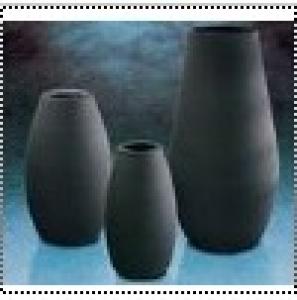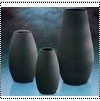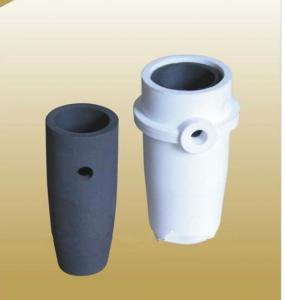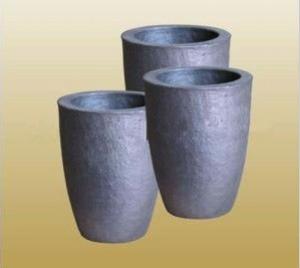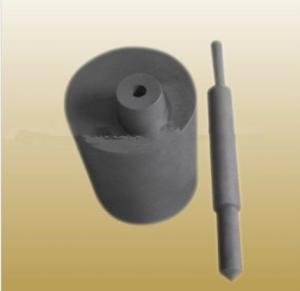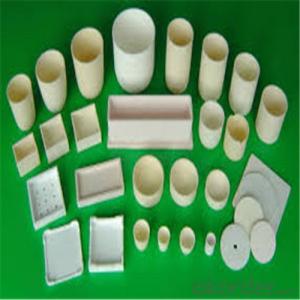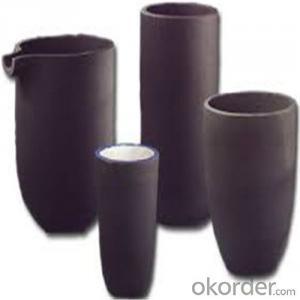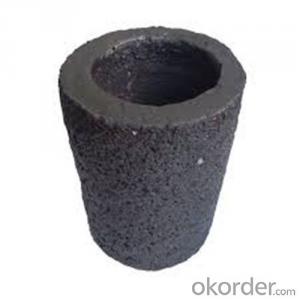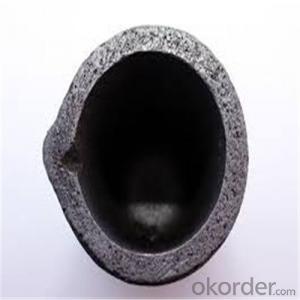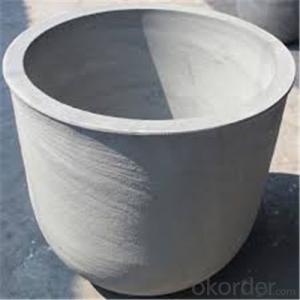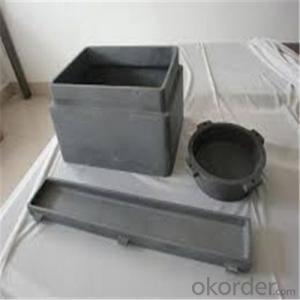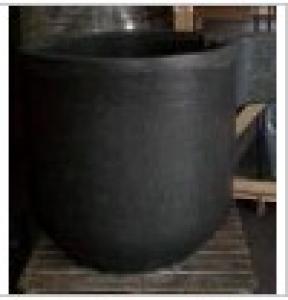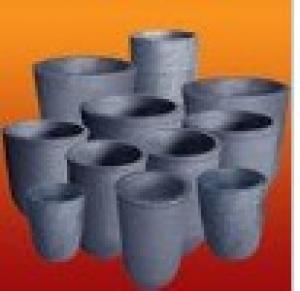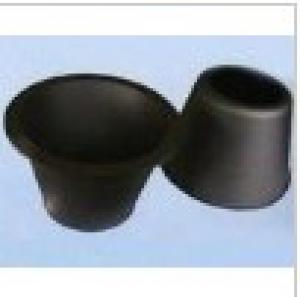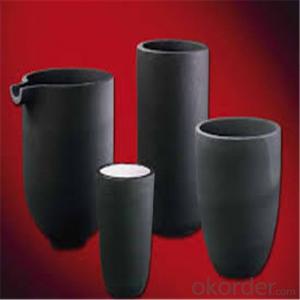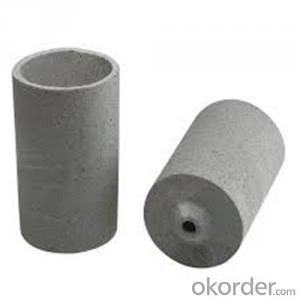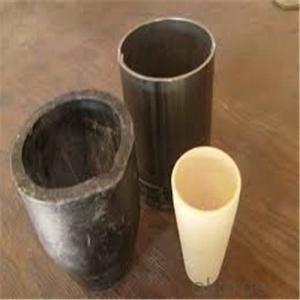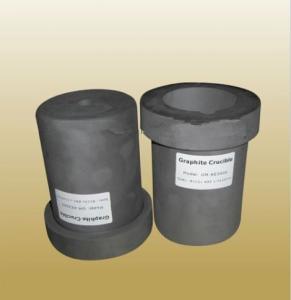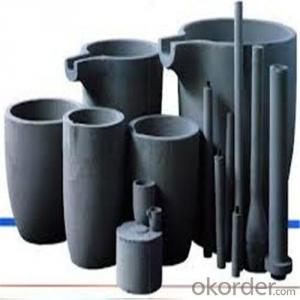Graphite Crucible with Lid
- Loading Port:
- China Main Port
- Payment Terms:
- TT or LC
- Min Order Qty:
- 50 Sets set
- Supply Capability:
- 5000 Sets per Month set/month
OKorder Service Pledge
Quality Product, Order Online Tracking, Timely Delivery
OKorder Financial Service
Credit Rating, Credit Services, Credit Purchasing
You Might Also Like
Detailed Product Description
graphite crucible is featured by fast heat conduction,long service life and low cost and the product finds good application
1.Garphite crucible can withstand the high temperature, an has good resistance to chemical erosions and thermal shock.
2.Graphite crucible is ideal for the melting of gold,silver,aluminum,copper and other metals and is also used as a tool for smelting jewelry.
- Q: Are there any special precautions to be taken while using graphite crucibles?
- Yes, there are a few special precautions to be taken while using graphite crucibles. Firstly, it is important to handle them with care as they can be brittle and prone to cracking. It is advisable to avoid sharp impacts or sudden temperature changes to prevent damage. Additionally, graphite crucibles can release small amounts of graphite dust, so it is recommended to wear protective gloves and a mask while handling them to avoid inhalation. Lastly, it is crucial to clean the crucibles properly after each use to remove any impurities or residues that may affect future experiments or reactions.
- Q: How does the wall thickness of a graphite crucible affect the melting process?
- The wall thickness of a graphite crucible affects the melting process by influencing the rate of heat transfer. A thicker wall can retain heat for a longer period, resulting in slower melting times. Conversely, a thinner wall allows for faster heat transfer, leading to quicker melting. Additionally, the thickness can also impact the crucible's durability and resistance to thermal shock.
- Q: Can graphite crucibles be used for electrode production?
- Yes, graphite crucibles can be used for electrode production. Graphite is an excellent material for electrodes due to its high melting point, thermal conductivity, and electrical conductivity. Graphite crucibles provide a suitable environment for melting and shaping metals to form electrodes, making them a common choice in electrode production processes.
- Q: Can graphite crucibles be used for carbonization processes?
- Carbonization processes can make use of graphite crucibles. Graphite is highly suitable for applications that involve high temperatures because of its exceptional thermal conductivity and resistance to thermal shock. Graphite crucibles are frequently employed in carbonization processes, where carbon-rich materials are heated to high temperatures without the presence of oxygen. These crucibles effectively contain and heat the materials. Graphite's high thermal conductivity ensures efficient transfer of heat, resulting in uniform heating and minimal heat loss. Furthermore, graphite's resistance to thermal shock enables it to withstand sudden temperature changes that occur during the carbonization process. In conclusion, graphite crucibles are a dependable and appropriate choice for carbonization processes.
- Q: What is the main function of graphite?
- As a conductive material: used for manufacturing the electrode, carbon nanotubes, carbon brush, and the positive electrode of the mercury rectifier in the electrical industry, graphite gasket, telephone parts, TV tube coating etc..
- Q: I'd like to smelt 104 aluminium alloy by medium frequency furnace. What should I pay attention to? Please point it out, thank you!
- Don't know what is your crucible material medium frequency furnace, if using graphite crucible, graphite as easily broken and easy to absorb moisture, must be handled with care to avoid the collision, but must be in use before the slow heating and drying, until the crucible to dark red, check no cracks can be put into the molten alloy. If the iron crucible, the Aluminum Alloy are strictly limited, so the iron, iron crucible, Tieshao, ladle, the tool must be coated with paint, paint is selling goods, components do not know, iron crucible and apparatus must also be preheated, exclusion of moisture. In addition, do not know you are refining aluminum ingot or making ah Aluminum Alloy parts, if the production parts should pay attention to defects of oxidation, slag and coarse grain, I am afraid that refining, refining agent are also ready to sell goods, how can read the instructions. Especially when smelting Caution!, preventing aluminum liquid splash, including many contents, such as inspection and testing, there is not much to say, the main note in the smelting process I thought so much, typing is slow, very hard ah, hey. Hope to be of some help to you.
- Q: How do you prevent contamination from the graphite crucible during melting?
- To prevent contamination from the graphite crucible during melting, several measures can be taken. One approach is to ensure that the crucible is thoroughly cleaned and free from any impurities before use. Additionally, using high-quality graphite crucibles that are specifically designed for high-temperature applications can minimize the risk of contamination. It is also crucial to handle the crucible with clean and dry tools to avoid introducing foreign substances. Finally, maintaining a controlled and stable melting environment, such as using a protective atmosphere or vacuum, can further prevent contamination by preventing the reaction of the crucible with surrounding gases or materials.
- Q: Cast iron into a casting. What is the state of the matter, change, sublimation? Sublimation? melt
- Container for molten iron called graphite crucible, good high-temperature resistance, it is higher than the melting point of iron.
- Q: Are graphite crucibles suitable for use in a vacuum environment?
- Yes, graphite crucibles are suitable for use in a vacuum environment. Graphite has a high melting point and excellent thermal conductivity, making it an ideal material for containing and heating materials in a vacuum. Additionally, graphite is chemically inert and has low outgassing properties, which ensures minimal contamination or reaction with the vacuum environment.
- Q: What are the different methods of preventing graphite crucible breakage?
- To prevent the breakage of graphite crucibles, there are various methods that can be utilized: 1. Ensuring proper handling and storage is crucial. Careful handling and avoiding sudden or rough movements that could cause impact or stress on the crucible are effective ways to prevent breakage. Additionally, storing the crucibles in a secure location, away from potential hazards or sources of damage, is important. 2. Following controlled heating and cooling procedures is essential. Graphite crucibles are exposed to high temperatures during the melting process, so it is necessary to heat and cool them gradually and in a controlled manner. This approach helps minimize thermal shock and stress on the crucible, thereby reducing the risk of breakage. 3. Preheating the graphite crucible before use can also prevent breakage. This involves gradually heating the crucible to a specific temperature range before adding the molten material. Preheating minimizes the temperature difference between the crucible and the molten material, thus reducing the risk of thermal shock and potential breakage. 4. Applying protective coatings to the graphite crucible provides an additional layer of protection against breakage. Coatings like boron nitride or alumina improve thermal shock resistance and decrease the likelihood of crucible failure. 5. Regularly inspecting and maintaining the graphite crucible is crucial. Regular inspections for any signs of damage or wear, such as cracks, chips, or defects, are necessary to prevent breakage. Addressing these issues immediately can prevent further deterioration. Additionally, routine maintenance, including cleaning and removing build-up or impurities, can prolong the crucible's lifespan and prevent breakage. By implementing these methods, individuals or industries can significantly reduce the risk of graphite crucible breakage, ensuring their longevity and optimal performance in various high-temperature applications.
Our products are sold all over the country, and exported to America, Germany, Spain, India, Japan and Korea. Besides, we have strict management and advanced production technology.
We promise we will win more clients and a larger market with honest commercial credit, high quality of products, competitive price and good service.
1. Manufacturer Overview
| Location | Inner Mongolia,China (Mainland) |
| Year Established | 2006 |
| Annual Output Value | US$2.5 Million - US$5 Million |
| Main Markets | 7.14% North America 7.14% South America 7.14% Eastern Europe 7.14% Southeast Asia 7.14% Africa 7.14% Oceania 7.14% Mid East 7.14% Eastern Asia 7.14% Western Europe 7.14% Central America 7.14% Northern Europe 7.14% Southern Europe 7.14% South Asia 7.14% Domestic Market |
| Company Certifications |
2. Manufacturer Certificates
| a) Certification Name | |
| Range | |
| Reference | |
| Validity Period |
3. Manufacturer Capability
| a) Trade Capacity | |
| Nearest Port | Xingang,Tianjin |
| Export Percentage | 31% - 40% |
| No.of Employees in Trade Department | 21-50 People |
| Language Spoken: | English, Chinese |
| b) Factory Information | |
| Factory Size: | 1,000-3,000 square meters |
| No. of Production Lines | 7 |
| Contract Manufacturing | 1,000-3,000 square meters |
| Product Price Range | Low and/or Average |
Send your message to us
Graphite Crucible with Lid
- Loading Port:
- China Main Port
- Payment Terms:
- TT or LC
- Min Order Qty:
- 50 Sets set
- Supply Capability:
- 5000 Sets per Month set/month
OKorder Service Pledge
Quality Product, Order Online Tracking, Timely Delivery
OKorder Financial Service
Credit Rating, Credit Services, Credit Purchasing
Similar products
Hot products
Hot Searches
Related keywords
